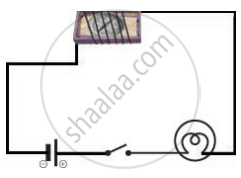Advertisements
Advertisements
Question
A golfer hits a ball at rest, such that the contact between the ball and golf stick is for 0.1 s. If the golf ball covers a linear distance of 400 m in 2 s, find the magnitude of force applied. Mass of golf ball is 50 g.
Solution
Distance covered by ball = 400 m
Time taken = 2 s
Distance 400
∴ Uniform velocity of the ball = `"Distance"/"Time"=400/2` = 200 ms−1
Now initial velocity of the ball = u = 0
Time for which force acts on the ball = t = 0.1 s
Final velocity of the ball after the force stops acting on it
= v = 200 ms−1
Using, v = ut + at
We have, 200 = 0 + a (0.1)
a = `200/0.1` = 2000 ms−2
Mass of the ball = m = 50 g = 0.05 kg
Force acting on the ball = F = ma
F = 0.05 × 2000
F = 100N
APPEARS IN
RELATED QUESTIONS
The north pole of a magnet ______ the north pole of another magnet.
A spring is compressed against a rigid wall. Draw a neat and labeled diagram showing the forces acting on the spring.
State one factor on which the magnitude of a non-contact force depends. How does it depend on the factor stated by you?
Give one example in each of the following cases where a force:
(i) Stops a moving body.
(ii) Moves a stationary body.
(iii) Changes the size of a body.
(iv) Changes the shape of a body.
'More the mass, the more difficult it is to move the body from rest'. Explain this statement by giving an example.
Two equal and opposite forces act on a moving object. How is its motion affected? Give reason.
Explain the following:
Why is it dangerous to jump out of a moving vehicle? How can the danger be minimised?
The force which acts on an object without physical contact. ______
Rocket works on the principle of conservation of
In the circuit shown in figure, when the key is closed, the compass needle placed in the match box deflects. Name the force which cases this deflection.

